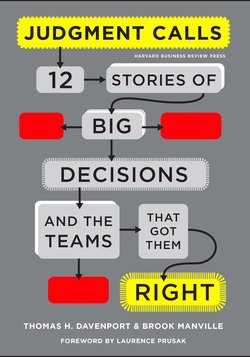Читать книгу Judgment Calls - Thomas H. Davenport - Страница 16
На сайте Литреса книга снята с продажи.
Learning from History
ОглавлениеAs the whole world knows, the first of those errors in judgment resulted in the fireball in the sky on January 28, 1986, when the space shuttle Challenger exploded in its second minute of flight, killing its entire crew. Despite concerns that cold weather could reduce the effectiveness of the O-ring pressure seals at the joints of the space shuttle's solid rocket motors, NASA managers had approved the launch of Challenger on that day, when the temperature at the Kennedy Space Center was barely above freezing. The spacecraft was destroyed as the failure of an O-ring to seal its joint allowed a jet of hot flame to escape and breach the shuttle's external fuel tank, causing a fatal ignition of the liquid hydrogen and liquid oxygen it contained.
Like every shuttle launch, the January 1986 mission was preceded by a flight readiness review (an FRR, in NASA acronymspeak), whose purpose was to evaluate issues that might threaten mission success and to withhold launch permission until those issues are resolved. Two weeks earlier, an FRR had certified Challenger ready for flight. Of course, participants in that meeting could not foresee how cold it would be two weeks hence. The day before the launch, NASA personnel became concerned about the weather; the solid rocket motor manager at Marshall Space Flight Center asked Morton Thiokol, the manufacturer of those motors, to review their safety in cold weather. In a series of teleconferences that evening, Thiokol engineers initially recommended against a low-temperature launch. But after their view was challenged by NASA shuttle managers, an offline “caucus” among engineers and managers at Thiokol reversed that recommendation. Challenger lifted off the next morning and was destroyed seventy-three seconds later.
The presidential commission set up to examine the Challenger disaster found that pressure to maintain the shuttle program's launch schedule led managers to minimize the seriousness of engineers' concerns about the O-rings.2 The perceived need for shuttle “productivity” certainly contributed to the error in judgment. Sociologist Diane Vaughn's detailed study of the launch-approval process in The Challenger Launch Decision offers a fuller and more nuanced explanation. Vaughn points to what she calls “the normalization of deviance” as a key factor. Because earlier cold or cool weather flights that suffered O-ring problems did not result in disaster, that initially unexpected damage was gradually accepted as normal. FRR participants had come to view it as an acceptable risk. In other words, the success of nearly two dozen previous missions led to complacency that failed to take the danger seriously enough. The result, says Vaughn, was “an incremental descent into poor judgment.”3
She also points to problems in the deliberative process during the January 27 teleconferences. NASA managers at Kennedy and Marshall Space Flight Center could not see the engineers at Morton Thiokol who had concerns about the O-rings. They missed the “body language” that could have helped expressed the engineers' unease; they were unaware of the local conversations between calls that might have given them a better grasp of the technical issue. As a result, the level of the engineers' concern was not clearly communicated. In addition, NASA's technical culture tended to discount the engineers' partly intuitive argument about the dangers.
So the multiple causes of bad judgment in this disastrous case include reluctance to credit “bad news” that would thwart schedule and productivity goals, complacency resulting from a history of success, and ineffective communication.
Seventeen years later, the only other fatal shuttle accident—the Columbia—occurred. It is unclear whether the crew could have been saved if NASA had understood the damage to Columbia while it was in orbit, but the board that investigated the disaster attributed the agency's failure to try to assess possible damage to many of the same factors behind the Challenger decision, especially the complacency born of many successes and communication failures.
This second accident and the criticisms in the Columbia Accident Investigation Board report strengthened NASA's resolve to address the cultural as well as the procedural flaws responsible for those fatal errors, and multiple changes to both process and culture were instituted over time.4 Looking now at the flight readiness review—for STS-119, the Discovery mission originally scheduled for launch on February 19, 2009, and finally launched nearly a month later, on March 15—will illustrate what the space agency has done to ensure the soundness of its judgments about flight viability and safety.
